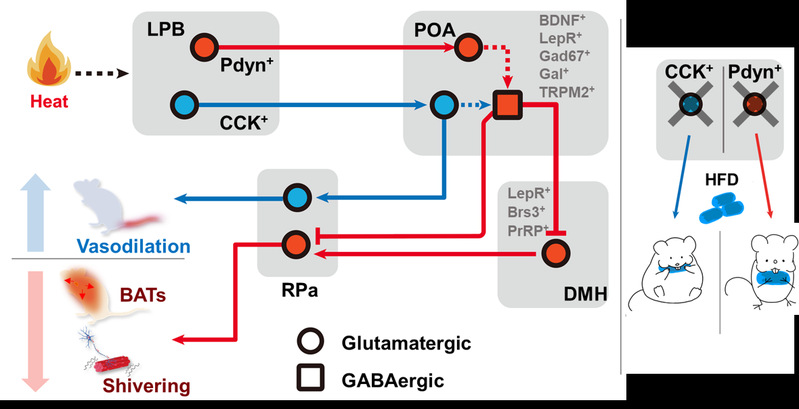On September 2nd 2020, Professor Shen Wei from SLST with his collaborators published a research paper entitled “Parabrachial neuron types categorically encode thermoregulation variables during heat defense”, in the international academic journal Science in Advances. This paper defined two key elements of the lateral parabrachial nucleus (LPB)-hypothalamic preoptic area (POA) circuitry during heat defense and demonstrated how the LPB neurons were encoding two different heat defense variables, which are also required for limiting fever development, and for regulation of energy expenditure and body weight homeostasis.
Heat defense variables include at least the inhibition of thermogenesis and the promotion of vasodilation. When the ambient temperature changes to a higher temperature of about 30-38oC from 25oC, temperatures of the core body (Tcore), interscapular brown adipose tissues (TiBAT), and tail (Ttail) change quickly. To identify the underlying genetic substrates in the LPB, the researchers adopted a cell type and projection-specific translational ribosomal affinity purification technique (retro-TRAP) based on a retrograde AAV. Sequencing data indicated that the prodynorphin (Pdyn) and cholecystokinin (CCK) are potential markers.

Fig. Proposed model for LPBPdyn/CCK circuits in regulating iBAT thermogenesis, vasodilation, muscle shivering, and body weight.
Subsequently, the researchers used optogenetics, chemogenetics, electrophysiological recording, and other technologies to study and prove that the Pdyn and CCK neurons in the LPB play an important role in heat defense, limiting fever development, regulation of energy expenditure and body weight homeostasis. In summary (as shown in Fig.1), this study successfully defined two types of LPB glutamatergic neurons with different genetic attributes: prodynorphin (Pdyn) and cholecystokinin (CCK) neurons, both of which can be used as heat defense regulating neurons to resist heat and limit the development of fever. Importantly, Pdyn and CCK neurons can each participate differently in the regulation of the inhibition of brown fat thermogenesis, the activation of vasodilation, and the inhibition of skeletal muscle shivering in varying degrees. Therefore, this study suggests that LPB is an important early regulatory hub in the thermoregulation pathway; it can perform preliminary classification and integration of heat afferent signals and then differentially regulate downstream peripheral heat-affected organs. These two types of neurons, Pdyn and CCK, may be potential targets for the treatment of diseases with abnormal thermoregulation.
In this paper, Yang Wen (Postdoc. from ShanghaiTech University), Du Xiaosa (PhD candidate from ShanghaiTech University), Zhang Wen (Chinese Academy of Sciences), and Gao Cuicui (PhD candidate from ShanghaiTech University) are the co-first authors, Professor Shen Wei and Yang Wen are the co-corresponding authors, and ShanghaiTech University is the first completion unit.
Link to the original paper: https://advances.sciencemag.org/content/6/36/eabb9414
Professor Shen Wei has long been engaged in researching the mechanism of energy homeostasis by the central nervous system. As a correspondending author, he has clarified the mechanisms of body temperature regulation and feeding regulation in journals such as PNAS (2017), Cell Research (2018), and Nature Neuroscience (2019). Related introductions and reports are as follows:
Shen’s lab: /sw/main.htm
Links to other Bioart reports by Shen’s lab:
https://mp.weixin.qq.com/s/Ae1Ghengbz1EQQZoRvU5ag
https://mp.weixin.qq.com/s/7YYYIQnoNiU9ThQTi7Ul-A


